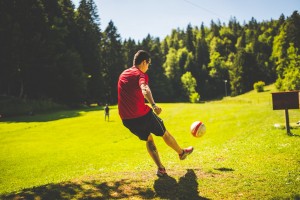 Whether your business landed a municipal contract, work for the city, or have a major corporate employer, caring for public green spaces requires different tactics from the residential lawns most care for. Chief among these is the use of aerating to combat soil compaction. These tips will help you keep lawns looking green, preserve plant life and maybe even prevent injuries.
Whether your business landed a municipal contract, work for the city, or have a major corporate employer, caring for public green spaces requires different tactics from the residential lawns most care for. Chief among these is the use of aerating to combat soil compaction. These tips will help you keep lawns looking green, preserve plant life and maybe even prevent injuries.
What Makes Caring for Public Areas Different from Private Lawns?
There are two contradicting factors at play:
– Visitors expect to see a healthy, green lawn, especially on sports fields.
– Foot traffic is much heavier than on a residential or commercial lawn.
In other words, compaction happens faster, while expectations are higher.
Ideally, the soil should be about 50% dirt and 50% air and water. As people, animals, and vehicles pass over the grass, the weight crushes the fragile support structure inside the soil. The resulting damage takes three main forms:
– Compacted soil can’t absorb water and air needed to support the root system. This weakens the grass and can prevent new grass roots from breaking through the soil.
– During heavy rains, precipitation pools on top of the soil, promoting mold growth. Heavy rains can be disastrous, washing away surface soil.
– Without airspace to absorb impacts, foot and ankle injuries increase.
In open areas, the greatest damage comes from “desire paths.” These are hard, grass-free trails created when people and animals walk the shortest path to get between two points. Usually, the best way to deal with these paths is to make them official, laying down gravel or concrete. Playgrounds and picnic areas have more distributed compaction, requiring field-wide care.
On sports fields, the wear and tear is more spread out, but at the same time can be more intense. Compaction happens deep within the soil, so the cleats worn by golfers, soccer players, and football players do nothing to stop the process.
Aeration vs. Tilling
If you’re breaking new ground to establish a new lawn or playfield, you’ll probably start by tilling the earth. This breaks up established plants to create a clean slate for new grass. The grinding action of the discs compacts the soil and flakes off small particles of dirt. While it may seem like you’re relieving compaction as you break up the top layer of dirt, you’re actually increasing it.
Spike or core aerating breaks up surface compaction gently without creating dust. This makes it easier for grass seeds and sod to take root in the soil, even if the ground was just tilled.
Core vs. Solid Tine Aeration
For years, core aerating has been the go-to for quality aerating. However, changes in tine design combined with new turf research are narrowing the gap between core and solid tine aeration.
The soil plugs left behind by core aerating are mowed after they’ve had a couple days to dry out. This creates a thin layer of fresh mulch on the grass. However, it’s unsightly, and recovery time can take several days. If you’re in a hurry, soil plugs can be picked up and mulched instead of grinding them into the soil.
Spike tines don’t leave plugs, and the holes they make are smaller. As a result, recovery times are shorter, and aerating requires less labor.
In most areas, the best results can be had by using core aerating at times when ground traffic is light, switching to spike aerating during the peak of the season. This gets the best results while keeping the area open as often as possible.
When and How Often to Aerate
Aerating may be needed once or twice a year on residential lawns, but some landscapers find that they need to aerate sports areas like soccer fields every 4-6 weeks during peak playing season. Testing the play area soil with a screwdriver is the easiest way to gauge compaction. If you have trouble pushing it in, it’s probably time to aerate.
The same rules you apply to residential aeration apply here: make sure the soil is moist, make sure the grass is out of hibernation, and lift the tines out of the soil before turning.
Keep Your Equipment Running Smoothly
Whether you have an AET Series, a PLUGR or a Next Gen, you can get everything you need for your Billy Goat aerator from www.billygoatparts.com. Our search engine has built-in factory diagrams and descriptions, making it easy to find parts that fit your equipment. Need something simple for your aerator’s engine? We have sections for popular engine parts from Billy Goat’s manufacturing partners. We ship parts and accessories across the U.S. and Canada.
